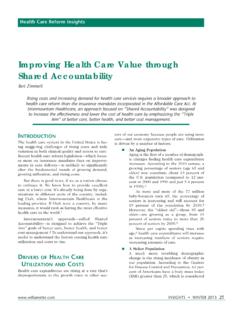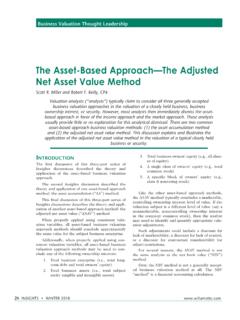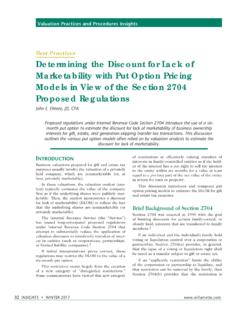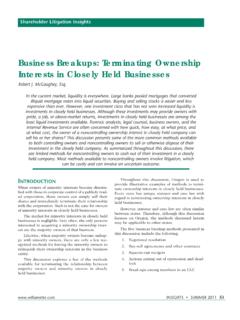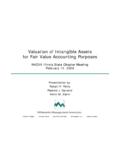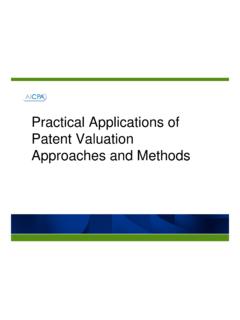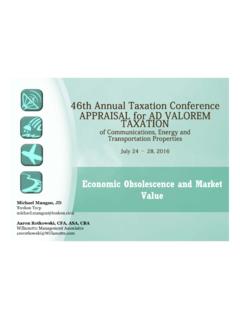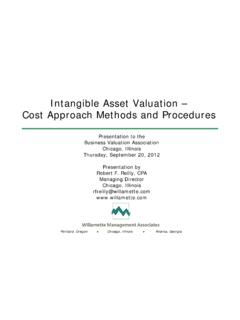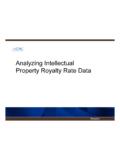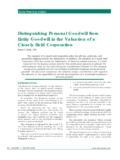Transcription of Estimating Capital Expenditures and Depreciation Expense ...
1 18 insights winter 2016 www .willamette .comEstimating Capital Expenditures and Depreciation Expense in the Direct Capitalization MethodAaron M. Rotkowski and Matt C. CourtnageGift and Estate Tax Valuation InsightsValuation analysts often rely on the income approach to estimate the value of operating companies for gift tax, estate tax, and generation-skipping transfer tax purposes. Two closely held business valuation variables that analysts frequently estimate when performing the business valuation income approach are (1) the projected Capital Expenditures and (2) the projected Depreciation Expense . These two valuation variables are related to one another and to other income approach valuation variables.
2 This discussion considers the relative valuation impact of Capital Expenditures and Depreciation Expense , especially with regard to various projected growth rate of the most basic concepts in business or secu-rity valuation is that the value of a security is equal to the present value of the expected cash flow from the ownership of that valuation relationship is equally true wheth-er the investment is a financial asset such as a Treasury bill, an ownership interest in real property, or an equity investment in an operating business investment valuation relationship is often expressed by the following formula:Formula #1: where: V = Value of the investmentI = Normalized next period incomeR = Required rate of returnThis simplified investment valuation formula is often referred to as the direct capitalization method.
3 Along with the yield capitalization method, the direct capitalization method is a common income approach valuation this valuation formula, an analyst can esti-mate the value of any investment or security if he or she knows (1) the investment s expected income and (2) the investor s expected rate of return on the this valuation formula only requires two inputs, Estimating a value for each of those formula inputs is a complex and often controver-sial component in this valuation formula is worthy of its own discussion. This discussion focus-es on the income portion of the direct capitalization method , this discussion presents best prac-tices when Estimating Depreciation Expense (often referred to as Depreciation throughout this dis-cussion) and Capital Expenditures .
4 This discussion considers those cash flow components as part of the direct capitalization discussion focuses on the applicability of, the strengths of, and the weaknesses of, selecting various levels of Capital Expenditures ( , greater than, equal to, or less than) relative to the selected level of Depreciation Leadershipwww .willamette .com insights winter 2016 19 This discussion does not focus on Estimating the specific levels of Depreciation Expense or Capital Expenditures to use in an income approach direct capitalization method valuation proFE ssion trEatmEnt oF Depreciation Expense and Capital ExpEnditurEsTwo surveys conducted in 2012 and 2013 demonstrate the degree to which valuation analysts vary on how to treat Capital Expenditures and Depreciation the 2012 survey, valuation analysts were asked whether Depreciation Expense should equal Capital Expenditures in a growth model.
5 44 percent said yes, 29 percent said no, and 27 percent said that those lev-els should depend on company growth and the 2013 survey, analysts were asked how they typically handled Capital Expenditures and deprecia-tion Expense when Estimating cash flow: 68 percent said they made them the same or very similar, 4 percent estimated Capital Expenditures less than Depreciation Expense , and 28 percent said they esti-mated Capital Expenditures materially greater than Depreciation surveys show that the consensus or default position among analysts is to set Capital expendi-tures equal, or nearly equal, to Depreciation Expense in their models. It is fair to assume that the majority of these models assume some level of position may be the analyst s default posi-tion.
6 This is because certain courts have accepted valuations where Depreciation and Capital Expenditures are offsetting, or because it is easier to perform and explain this adjustment than to justify why the amounts for Depreciation Expense and capi-tal Expenditures should is the consensus opinion that the majority of operating companies subject to valuation for gift, estate, and generation-skipping transfer tax purposes warrant a positive long-term growth rate. A valuation model that assumes a 0 percent or negative long-term growth rate is typically only appropriate in extraordinary a situation with zero or negative expected growth, business owners may:1.
7 Achieve positive growth by adjusting opera-tions,2. scale back production or services offered to a point at which long-term growth will be positive, or3. cease operations, either gradually over time or more discussion provides information that ana-lysts can consider when making such estimates, analyses, or Ect capitalization mEthod oVErViEwThe application of the direct capitalization method requires the analyst to apply several principles. The principles that are relevant to this discussion include the following:1. The selected discount rate should be appro-priately matched to the selected measure of The selected growth rate should be appro-priately matched to the selected measure of Income should be normalized that is, income should only include income or Expense items that are expected to recur in detailed examination of these principles is outside the scope of this discussion.
8 And, a detailed examination of these principles is not necessary since (1) these principles represent generally accepted valu-ation theory and (2) they are not , this discussion presents an overview of these three principles because they are relevant to the subsequent discussion about Depreciation Expense and Capital #1: Discount Rate and Income In the direct capitalization formula, the selected dis-count rate (or rate of return) should be appropriately matched to the selected measure of income. The fail-ure to properly match income with the discount rate is a fundamental flaw of the application of the direct capitalization to Cost of Capital , A very common type of error in applying the income approach to valuation is to use a discount or capitalization rate that is not appropriate for the definition of economic income being discounted or capitalized.
9 This general category of error has almost infinite variations. 3 The appropriate discount rate is one that includes a rate of return for each component of the selected 20 insights winter 2016 www .willamette .commeasure of income. For example, if the selected mea-sure of income includes a return from debt ( , it is estimated before the deduction of interest Expense ) and a return from equity, then the appropriate dis-count rate is one that considers the required rate of return from both debt Capital and equity , if the income return is an after-tax return, then the discount rate should be an after-tax discount the valuation of an operating company using the direct capitalization method, income is often estimated as subject company net cash flow to invested cash flow to invested Capital (NCF) is typi-cally calculated as follows:Formula #2.
10 Net income+ Tax-affected interest Expense + Depreciation Expense Capital Expenditures +/ Changes in net working Capital = NCFWhen valuation analysts use Formula #2, they often think of Depreciation Expense and Capital Expenditures together. This is because Depreciation Expense is a function of Capital the direct capitalization method, Capital expen-ditures should either:1. exceed Depreciation ,2. be equal to Depreciation , or3. be less than appropriate discount rate based on the NCF formula presented in Formula #2 is the weighted average cost of Capital (WACC) minus the estimated long-term growth rate of NCF (the LTG rate ).In this example, the WACC is based on both:1.
